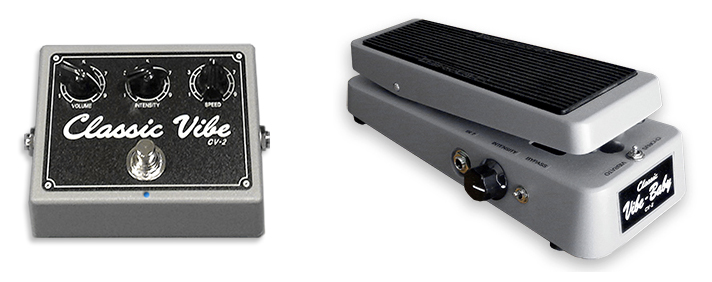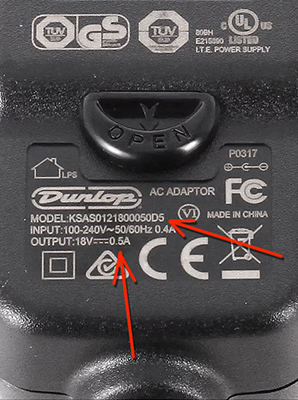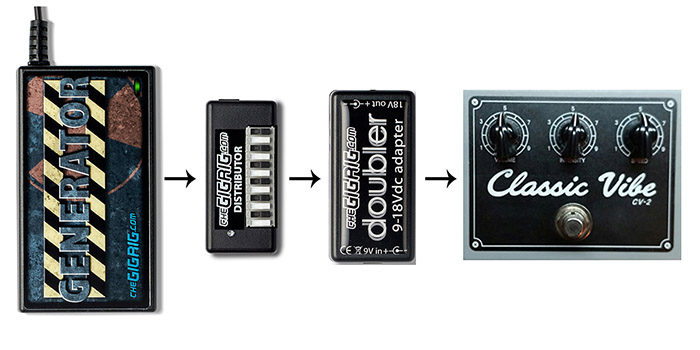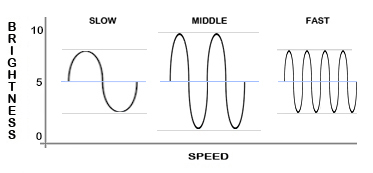
F.A.Q.

The following are the most Frequently Asked Questions we get about Classic Vibe CV-2TM and Vibe-Baby CV-2TM pedals. I am posting these questions and answers here as it saves me from re-typing all this stuff over-n-over when replying to these same questions asked in emails.
Q: "Do you have any Classic Vibe CV-2TM or Vibe-Baby CV-2TM ready-to-ship?"
A: No, we build each Classic Vibe CV-2TM and Vibe-Baby CV-2TM per order, at Classic Amplification we are a bespoke business, when you order and pay, then we build and ship. The time is normally 60 days from order-to-ship.

Q: "What is the difference in sound/tone between the Classic Vibe CV-2TM and Vibe-BabyTM?"
A: None.
The Classic Vibe CV-2TM is voiced to closely emulate a few specific vintage uni-vibes that have come through my shop. The original vintage Uni-Vibe effect pedal has a noticably smoother sound than contemporary vibes, one might even say a bit less pronounced and no (or very little) quirky-jerk at the end of the sweep, and the sweep seems almost asymetrical.
Q: "Does the Classic Vibe CV-2TM and Vibe-Baby CV-2TM have a True Bypass switch"
A: Yes, our Classic Vibe CV-2TM and Vibe-Baby CV-2TM both have true bypass mechanical switches to completely remove the effect circuitry from your signal chain when not in use. The original vintage Uni-Vibe did not have true bypass at all, we add it just because modern pedal users expect it. True Bypass makes absolutely no contribution to getting the vintage sound/tone.
Those who are after the traditional Hendrix/Trower/Gilmour sounds will not (exactly) achieve it using true bypass for I/O, you should be using the "Cancel" switch which leaves the vibe's preamp engaged (instead of bypassed out) which is a big part of getting the sound.
The Vibe-Baby CV-2TM uses a side mounted DPDT bypass switch mounted on the side next to the INTENSITY knob. Using the Vibe-Baby CV-2TM, one should use true bypass only for setting-up the pedal (in/out of the signal chain) before and after the song it is needed for, and the actual starting/stopping of the vibe'ing effect (during a song) should always be done with the heel-down "cancel" function. This most closely emulates the true vintage use of the pedal.
Q: "Does the Vibe-Baby have the heel-down "cancel" like the original univibe's speed pedal?"
A: Yes, our Vibe-Baby CV-2TM has heel-down "cancel" just like the original uni-vibe's foot control pedal did. The cancel function is the method you would use to start/stop the vibe during a song performance.
Q: "Is "Cancel" the same thing as "True Bypass"
A: No.
Original vintage Uni-Vibe pedals had no true bypass option, instead they used a "Cancel" switch which was a method of turning on/off the noticable "vibing" effect. What the cancel switch does is stop the internal light bulb (lamp) from flashing, which in turn causes the sound to stop modulating but the whole signal chain was still intact and not bypassed.
Q: "What polarity should the power plug be on my power pack?"
A: Industry standard power plug polarity is: Center Negative (-)
and is shown with this symbol:

All current production Vibe-Baby CV-2TM and Classic Vibe CV-2TM pedals are Center Negative (-) polarity. Using a power unit with the wrong polarity will likely cause damage to the pedal.
Q: "Why 18vDC and not 9vDC like other pedals?"
A: Because at 9vDC a vibe just doesnt sound right, not like an original Uni-Vibe anyway.
The original vintage Uni-Vibe pedals plugged into the AC mains and internally had a step-down transformer that supplied about 20vDC. Modern power packs, "wall warts", plug-packs, of the higher (than 12V) output type are normally found in 18V or 24vDC versions. The 24V versions are harder to source so we chose to go with 18vDC and modified the internal bulb driver circuitry slightly to optimise for 18vDC.
Recently Dunlop Mfg has come out with a new ECB-004 power pack that supplys 18V 500mA (0.5A) and works with our vibe pedals, the power pack is sold under the their old part number (ECB-004) so you will need to be aware of that when ordering a ECB-004 power pack.
(The old ECB-004 was a 250mA unit, and does not work with our vibes)
The new power packs show
18V 0.5A
on the data label:


I have tested the new ECB-004-US power pack myself, and one of my very good customers has been giving it some time-testing and it is working very well so far and has been for some time now (thank you BruceT).
GigRig
One of our customers is using this setup, he reports this setup is working well for him:

Pedal Board Power Units
Q: "What pedalboard power units work well for this pedal?"
A: An outdated list of isolated power units which may work for you can be found here: Isolated Power Unit List.
Classic Amplification never advises our customers to use stacking or daisy-chain power cable adaptors (coupling two 9V channels together) because that often causes problems and noises when running a vintage built vibe pedal.

Q: "Why am I hearing a strange noises/hum/clicks/whistles from my vibe?"
A: Most likely it's because of a regulator chip in your power unit.
This MP3 audio file is an example of just one of the weird noises that wonkey regulators can cause/inflict in a uni-vibe circuit:
Many "regulated" power units and wall-warts do this when used to power a vintage vibe circuit (our vibes use the vintage circuit). There is no label or spec-sheet that alerts us which power units will cause noise in a vibe so we're pretty much on our own to find out ourselves. Just an FYI, vintage (Shin Ei) uni-vibes did not use regulators.
Q: "I already have a power-pack/wall-wart/plug-pak here, will it work?"
A: Maybe, maybe not. No way I can tell from here.
(yes, this an actual question I've been asked)Many power pack wall-wart units work but be aware some of the voltage regulators used in the less expensive ones can cause a weird background noise that sounds like a whine in sync with the Vibe's speed which we call "regulator cry".
Many switching type power packs will work, but some won't (like the single 1-spot unit), and the ones that don't will make weird noises in the vibe unit. Not all "switching" types do this and you might find one that works fine. For instance the Panasonic cordless telephone I have in the shop has one which works just fine on a vibe, it's a hit-n-miss thing using random "switching" type power packs, so be aware and try them out before you need to gig with it.
Q: "Why does the Speed setting interact with the Intensity setting?"
A: That interaction is exactly how a vintage uni-vibe operates, it because of the old-school (1967) design of the LFO.
The "Low Frequency Oscillator" (commonly referred to as the LFO) is where this happens as it drives the lamp part of the circuit.
The LFO in a Uni-Vibe, and our Classic Vibe CV-2TM and Vibe-Baby CV-2TM is an old design which by todays standards would not be used in an effect pedal. Without getting into the electronics of it all, it's easier to understand that there is a sweet spot for the LFO and Lamp Driver circuits where the LFO provides more drive in the middle of the speed range. It is a non-linear thing which is also why a vintage vibe sounds different a modern (ie; Dunlop FET type) vibe.
This graphic shows how the brightness of the lamp/bulb increases in the middle of the speed range, and how it is less bright at the slow and fast ends of the range:

It is a weird side-effect of the vintage design, but if we "fix" that, we loose some of the unique character of the vintage pedal and so we keep it in our Classic Vibe CV-2TM and Vibe-Baby CV-2TM to retain the true character of a vintage Uni-Vibe.
Q: "When I use the cancel switch to turn it ON, there is a slight delay, what's up with that?"
A: That delay is exactly how a vintage uni-vibe operates, and because our vibe is a reproduction of the vintage uni-vibe circuit it too has that "feature", and again, if we "fix" that, we loose some of the unique character of a vintage pedal.
All references on this page to the name "Uni-Vibe" are specifically referencing the original effect pedal made in Japan by the Shin Ei Co in the late 1960's to mid 1970's and not any other brand or maker of vibe pedals. Currently the trade name Uni-Vibe® is a registered trademark of Dunlop Manufacturing who does not manufacture vibes like the vintage Shin-Ei (Japan) uni-vibes pictured on this webpage, they make their own version which does not use Lamp & Photocells as the vintage (Shin-Ei Japan) units did.
